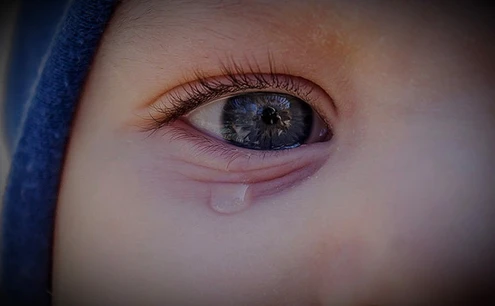Causative Agents: Staphylococcus aureus and Streptococcus are common culprits.
Examples: Stye (hordeolum), chalazion, bacterial blepharitis.
Causative Agents: Herpes simplex virus (HSV) or varicella-zoster virus (VZV).
Examples: Herpetic blepharitis, eyelid herpes.
Triggers: Allergens like pollen, dust, or pet dander can cause eyelid inflammation.
Causative Agent: Demodex mites can infest the eyelid margins, leading to irritation.
Risk Factors: Frequent eye rubbing or inadequate eyelid cleaning can contribute to infections.
Swelling and Redness: Common indicators of eyelid infections.
Pain or Tenderness: Frequently observed in styes or chalazia.
Itching and Burning: Common in allergic or parasitic infections.
Eye Discharge: Yellow or green discharge is indicative of bacterial infections.
Crusting of Eyelids: Most noticeable in the morning.
Sensitivity to Light (Photophobia): Seen when the infection spreads to the cornea.
Description: A bacterial infection of the eyelid's oil glands.
Symptoms: Painful lump, redness, swelling.
Description: A blocked oil gland leading to inflammation.
Symptoms: Painless lump, mild redness.
Description: Inflammation of the eyelid margins.
Symptoms: Itching, redness, crusting.
Description: Caused by herpes simplex virus.
Symptoms: Painful blisters, redness.
Description: A bacterial infection of the eyelid and surrounding tissues.
Symptoms: Swelling, redness, fever.
Clinical Examination: Performed by a pediatric ophthalmologist to assess the eyelids and surrounding areas.
Eyelid and Discharge Evaluation: Swelling, redness, and discharge are closely observed.
Laboratory Tests: Swabs of discharge may be taken to identify the causative organism.
Medications: Antibiotic eye drops or ointments (e.g., erythromycin, tobramycin).
Therapies: Warm compresses to reduce swelling and promote drainage.
Medications: Antiviral eye drops or ointments (e.g., acyclovir).
Symptomatic Relief: Pain and swelling management.
Medications: Antihistamine eye drops for itching and redness.
Severe Cases: Steroid eye drops (used cautiously).
Hygiene: Eyelid cleaning solutions to remove Demodex mites.
Medications: Antiparasitic treatments, if needed.
Procedures: Incision and drainage for large or persistent chalazia.
Hand Hygiene: Teach children to wash their hands frequently.
Eyelid Hygiene: Regular cleaning with warm water or prescribed solutions.
Avoid Eye Rubbing: Discourage children from rubbing their eyes.
Allergen Avoidance: Minimize exposure to known allergens.
Turkey is a leading destination for the treatment of eyelid infections in children, offering world-class medical care at competitive prices. The country is renowned for its advanced healthcare infrastructure, experienced specialists, and affordable treatment options, making it a popular choice for medical tourism.
Expert Specialists: Turkey boasts highly skilled pediatric ophthalmologists, such as Dr. Ayşe Dolar Bilge, specializing in treating eyelid infections.
Advanced Technology: Hospitals and clinics in Turkey are equipped with state-of-the-art diagnostic and treatment tools.
Affordable Costs: Treatments are significantly more affordable compared to many Western countries.
Medical Tourism Services: Many hospitals offer comprehensive packages for international patients, including: Airport transfers. Accommodation. Translation services. Post-treatment care.
Cultural and Historical Appeal: Families can explore Turkey’s rich culture, history, and natural beauty during their visit.
Parents can arrange online consultations with specialists like Dr. Ayşe Dolar Bilge.
Personalized treatment plans are created after diagnosis.
Clinical examination and symptom evaluation.
Laboratory tests (if required) to identify the infection.
Medications such as antibiotics, antivirals, or antihistamines.
Warm compresses and eyelid hygiene instructions.
Surgical intervention for severe cases.
Detailed post-treatment instructions are provided to parents.
Follow-up appointments are scheduled to monitor recovery.
High success rates and patient satisfaction.
Comprehensive care from diagnosis to recovery.
Affordable pricing with transparent costs.
Support for international patients, including language assistance.
Seek medical attention if your child shows symptoms of an eyelid infection.
Follow prescribed treatment and hygiene recommendations.
Choose a reputable clinic or specialist experienced in pediatric eye care.
Eyelid infections in children are common but highly treatable conditions. Early diagnosis and proper treatment ensure a quick recovery and prevent complications. Turkey, with its advanced medical facilities, experienced specialists like Dr. Ayşe Dolar Bilge, and affordable pricing, is an excellent destination for treating these infections. Whether local or international, families can trust Turkey for exceptional care and results. If your child exhibits symptoms of an eyelid infection, consult a specialist to explore treatment options.
